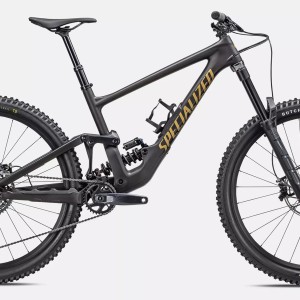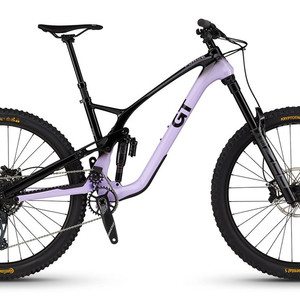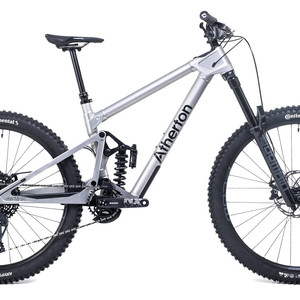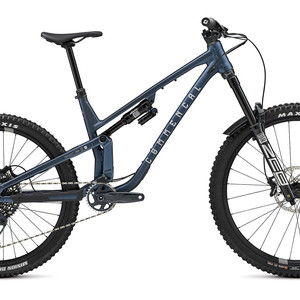2021 Kona Process X Bike
(discontinued)
| Where To Buy | |||
|---|---|---|---|
Free shipping on orders over $50 (continental U.S. only).
International shipping available. Some exclusions apply. |
|||
Free shipping on orders over $50 (continental U.S. only).
International shipping available. Some exclusions apply. |
|||

What an era to be a mountain biker! It seems gone are the days of spending an entire day loading up downhill bikes in your buddy’s beater truck and hauling up a winding dirt road for a handful of loose runs before dark. Now, options are endless for efficient, pedal-hungry enduro bikes that excel on steep, rough and aggressive descents. Answering the calls of adrenaline-starved riders is Kona with their Process X — a brave, capable, carbon 29er ready for serious action.

Strengths
| Weaknesses
|

Highlights
- Kona carbon frame front and rear with aluminum rocker
- 29-inch wheels with 27.5-inch rear wheel (mullet) compatibility
- 161mm rear wheel travel // 170mm front
- Beamer linkage-driven single-pivot suspension design
- Tapered headtube
- Alternating internal and external routing
- PF92 BB with ISCG mounts
- Rear Boost spacing with adjustable chainstay length dropouts
- MSRP $5,199 USD

The Process X is Kona’s interpretation of an all-around gravity bike, a few millimeters squishier and more aggressive than their Process 153 line. As Kona puts it, “the Process X and Process X DL are our answer to big days of gravity-fueled riding.” Kona didn’t want to pigeonhole this bike into the enduro race segment, but it is the bike of choice for Kona factory rider Connor Fearon and Miranda Miller. None of this is particularly surprising; the thing just looks fast. Its low-slung stature and ample suspension is unapologetically gravity-oriented.
The Process X isn’t just a longer-travel version of the other Process models. The suspension sports greater progressivity and the geometry has more adjustability. Along with the frame’s dual-position chainstay is the option to swap a 27.5 wheel in the rear and *mullet* the bike.
First Impressions
Looking at the frame from a distance, besides the good looks, we didn’t see anything that really popped out — the bike is clean. The cable routing was well managed, and overall the frame was a refreshingly simple layout. The tubes don’t look massively burly, but that is deceptive. From above, the bike has a relatively wide stance. The wide pivots and oval-shaped tubes offer a very stable platform. That wide stance also provides ample rear tire clearance.

As we zoomed in closer to the bike, the sparkly paint and fine details started to take shape. The bearings are relatively large, but there was quite a bit of exposure to the elements. We would have loved to see a second seal or cap to reduce the volume of contaminants the bearing could be exposed to. In addition to the bearing exposure, we did notice that the lower shock bolt was held in by two significant ribs on the downtube. These ribs could potentially trap contaminants in the 'tray' that it forms. Fortunately, those worries were unfounded for the duration of our test. But, it’s something to consider over the long haul as continually leaving contaminants near that lower shock bolt could result in premature wear of the lower shock bushing.
We were hoping to see a threaded bottom bracket, but we were presented with a PF92 instead. That same region includes ISCG tabs, but one thing kind of surprised us, this bike didn’t come with a chainguide. It’s not a huge deal, but we would expect at least upper chainguide integration for a bike of this classification. The more expensive Process X DL is also chainguide-free off the shelf.

Geometry
The evolution of longer and slacker bikes, especially in the trail/enduro segment, is not something the bike industry has been consistent with for the last few years. Whether this is demand driven or a hyped up trend is a worthy debate. However, there is no denying, for certain terrain and types of riding, the benefits are real. Going through the geometry chart for the Process X shows measurements we have come to expect from an aggressive, 160/170mm-travel enduro bike.


The Process X needs to be pushed by both the rider and the terrain.
Kona bikes have earned the reputation of being fun. The suspension itself offers plenty of pop out of corners and while pumping terrain. That spritely nature also makes the perceived weight of the bike feel quite a bit less than the mid-30-pounds that it is. That suspension feel is sure-footed, but we wouldn’t call it a playful bike. This isn’t a bike that you will grab to go jibbing with your friends. When in its element — at speed and in the steeps — the Process X makes quick work of sketchy situations. This bike needs to be pushed. The Process X needs to be pushed by both the rider and the terrain.

Kona continues to maximize its Beamer Independent Suspension platform which does have a noticeable beginning stroke ramp which transitions into a relatively linear feel on trail. We enjoyed this initial stroke support especially when pumping through berms and trail features, as well as the quick recovery the Process X has on consecutive hits.
We found the bike easy-to-tune to our liking and we just kind of forgot about it after that. In the best way possible, the suspension just faded into the background. There weren’t any peculiarities. Even climbing, while not best-in-class, was better than we thought it would be.
At about 85% anti-squat at sag, the bike is not particularly firm on the pedals. The steep (78 degree) seat tube helped in these situations, and the climb switch was available to firm up the rear end. We were never going to win a climbing contest while riding this bike. Despite the shortcomings, we didn’t find ourselves cursing our way to the top either. We succesfully piled up many 4+ hour excursions on the Process X without much drama. At the end of the day, we just accepted the climbing tradeoffs for the descending characteristics were worth it.

Build Kit Performance and Value
Dropper post
The only component that we had an issue with was the Trans X dropper post. The post came with 200mm of drop, but is adjustable up to 30mm in 10mm increments. We really appreciate the ability to refine the amount of drop available, but near the end of the test we began to have issues with the post returning to full travel. When researching the post, it unfortunately turns out that the damper is not rebuildable. Instead, a $75 damper cartridge replacement is required if an issue arises. Historically, we've had no problems with less-expensive 150mm drop Trans X posts on sub-$3000 bikes, so to see this model with more features struggle was a disappointment.
Fork and Shock
The FOX 38 Performance fork with Grip damper was a solid performer throughout the test. But we're a bit surprised that the Performance Elite 38 fork wasn't spec'd, as we've seen that fork on similar bikes in this price range. The 3-position compression and low-speed rebound adjustment of the Performance model may feel limiting, especially considering the naughty places one could put the Process X. We can be two-faced at times, and in the past we've wondered if maybe there was too much adjustment on the higher-end FOX forks, so we'll re-iterate that the 38 Performance fork held up well and took the hits through our test all with an easy-to-set-up package. We'll continue the thought with the Float DPX2 Elite shock, however. Setup was easy and performance was great for the riding we did, but as stated, the Process X chassis was ready for more. We wonder if the DPX2 would eventually be overcome after repeated and extended periods of gnar.

Tire Performance
The combination of Maxxis Assegai and DHR II are well renowned for a reason. The consistent traction suits this bike very well. The choice of EXO+ was sufficient for most of our rides, but we would opt for a burlier DoubleDown or even DH casing for rugged summer riding when we could push the Process X to its limits in our area.
Wheel Performance
The wheels were a bit of a mystery. We tried finding information on these WTB KOM Trail rims, but with no such luck. We would assume that these rims would be similar to their ‘stout’ variant, but the ‘trail’ classification had us scratching our head. Naming convention aside, they offered plenty of compliance and survived the test period, which was a relief, as we've smashed up some lighter WTB rims in past tests.

Brake Performance
The 4-piston Shimano Deore brakes continue to impress (See our Deore review for more). If you like the feel of Shimano brakes, then these Deores will give you control and power when you need it, without frills, fade or wander. Under a blind test, these brakes would have fooled us into thinking that they were a more expensive variant.
Drivetrain
The drivetrain selection was well-thought-out. The choice of a Shimano XT shifter was fantastic, nice bling with the XT derailleur, and the SLX cassette is ready to work. The Deore crank isn't flashy, and any extra weight at the bottom bracket is hardly noticeable, but they may offend some label hunters. Overall, the drivetrain held up very well, even with our torrential PNW excursion. Despite riding through dust and sand or rivers and muddy puddles, the shifting has been flawless throughout the duration of the test. The PF92 bottom bracket remained creak-free as well.

Long-Term Durability
The frame seems stout and prepared for the long haul. The frame has rubber protection throughout to suppress chain noise and protect the downtube from both rock strikes and tailgate pad wear. We would have liked to see the bearings less exposed, and a threaded bottom bracket is preferred these days for ease of maintenance if nothing else. Throughout the test, we did not have any reliability or noise issues with the Process X frame. The paint was durable, and the limited lifetime warranty on the frame, as well as the one-year warranty for the whole bike, is enough reason to be confident.


Other than the dropper post, we didn’t have any other issues with the Process X. We also don’t see any good reason to spend $2,000 more for the Process X DL model. Sure, it has some nicer spec, but we'd put the money toward a Grip 2 damper upgrade in the fork or a 27.5-inch rear wheel to have for #mulletlife experimentation. The rest of our dough can go toward trips to the bike park to bring this machine alive.

What's The Bottom Line?
Looking to offer a bike for their top EWS riders and weekend senders alike, Kona has delivered with the Process X. It has modern geometry, chainstay adjustability and mixed wheel size possibilities, and a decent spec that's ready for plenty of trail smashing. If you like on being over-biked on local trails that aren't all that rowdy, even so, this is not the bike for you. You may want to look into the Process 153 or better yet, the very versatile Kona Process 134 that we enjoyed and would excel as a true daily driver. The Process X is for riders who need a big bike capable of tackling legitimately tough, fast trails. A do-it-all bike, this is not...and that's a good thing.
Visit www.konaworld.com for more information
Vital MTB Rating
- Climbing: 3.5 stars
- Descending: 4.5 stars
- Fun Factor: 4 stars
- Value: 3.5 stars
- Overall Impression: 4 stars
Specifications
Rear: Maxxis Minion DHR II, 3C, EXO+, TR, 2.4" WT (29" on MD/LG/XL; 27.5" on SM)
MD/LG/XL have 29" wheels; SM has Mixed ("Mullet") wheels: 29" front, 27.5" rear
Chainstay and wheelbase lengths adjustable via modular rear dropouts
Geometry adjustable via flip chip in rocker link to allow 27.5" or 29" rear wheel
Internal cable routing
| Where To Buy | |||
|---|---|---|---|
Free shipping on orders over $50 (continental U.S. only).
International shipping available. Some exclusions apply. |
|||
Free shipping on orders over $50 (continental U.S. only).
International shipping available. Some exclusions apply. |
|||
























28 comments
Post a reply to: Kona Process X Review - This is Not a Do-It-All Bike, and That's